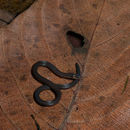ar
الأسماء في صفحات التنقل


This species is recognized to occur in the Philippines and Malaysia. In the Philippines, this species is widely distributed, and has been documented to occur on the islands of Luzon, Polillo, Mindoro, Tablas, Panay, Negros, Cebu, Mindanao, and Basilan.
Luzon, Mindoro, Visayan (central), and Mindanao Pleistocene Aggregate Island Complexes (PAIC; Brown and Diesmos, 2002), as well as the Romblon Island Group.
Calamaria gervaisii, commonly known as Gervais's worm snake, is a species of relatively small-sized burrowing or fossorial snake in the family Colubridae. This Snake feed on Earthworms and can grow maximum of 1FT or 30CM in length
The specific name, gervaisii, is in honor of French zoologist Paul Gervais.[2]
Calamaria gervaisii is endemic to the Philippine Islands.[3] Its range includes the islands of Basilan, Catanduanes, Cebu, Lubang, Luzon, Mindanao, Mindoro, Negros, Panay, Polillo, and Tablas.[1]
C. gervaisii is found from near sea level up to altitudes of 1,000 m (3,281 ft). It lives in forests and plantations, burrowing in the leaf litter and hiding under stones and fallen logs, or between the buttresses of trees.[1]
The IUCN has listed Calamaria gervaisii as being of "least concern" because it has a wide range, appears to be abundant with a stable population and seems to be tolerant of disturbance to its natural habitat. No particular threats to this species have been identified.[1]
Calamaria gervaisii, commonly known as Gervais's worm snake, is a species of relatively small-sized burrowing or fossorial snake in the family Colubridae. This Snake feed on Earthworms and can grow maximum of 1FT or 30CM in length
Calamaria gervaisii, comúnmente conocida como serpiente gusano de Gervais, es una especie de serpiente excavadora o fosorial de tamaño relativamente pequeño de la familia Colubridae.
El nombre específico, gervaisii, es en honor al zoólogo francés Paul Gervais.[2]
C. gervaisii es endémica de las islas Filipinas.[3] Su área de distribución incluye las islas de Basilan, Catanduanes, Cebú, Lubang, Luzón, Mindanao, Mindoro, Negros, Panay, Polillo, y Tablas.[1]
C. gervaisii se encuentra desde cerca del nivel del mar hasta altitudes de 1000 metros. Vive en bosques y plantaciones, excavando en la hojarasca y escondiéndose bajo piedras y troncos caídos, o entre los contrafuertes de los árboles.[1]
La UICN ha incluido a C. gervaisii como de "menor preocupación" porque tiene un rango amplio, parece ser abundante con una población estable y parece tolerar la alteración de su hábitat natural. No se han identificado amenazas particulares para esta especie.[1]
Calamaria gervaisii, comúnmente conocida como serpiente gusano de Gervais, es una especie de serpiente excavadora o fosorial de tamaño relativamente pequeño de la familia Colubridae.
Calamaria gialaiensis Calamaria generoko animalia da. Narrastien barruko Colubridae familian sailkatuta dago.
Calamaria gialaiensis Calamaria generoko animalia da. Narrastien barruko Colubridae familian sailkatuta dago.
Calamaria gervaisii est une espèce de serpents de la famille des Colubridae[1].
Cette espèce se rencontre aux Philippines et au Sabah en Malaisie[1].
Cette espèce est nommée en l'honneur de Paul Gervais.
Calamaria gervaisii est une espèce de serpents de la famille des Colubridae.
Calamaria gervaisii[4] este o specie de șerpi din genul Calamaria, familia Colubridae, descrisă de Duméril, Bibron și Duméril 1854.[5][6] Conform Catalogue of Life specia Calamaria gervaisii nu are subspecii cunoscute.[5]
|access-date= (ajutor)Mentenanță CS1: Nume multiple: lista autorilor (link)
Calamaria gervaisii este o specie de șerpi din genul Calamaria, familia Colubridae, descrisă de Duméril, Bibron și Duméril 1854. Conform Catalogue of Life specia Calamaria gervaisii nu are subspecii cunoscute.
Calamaria gervaisii là một loài rắn trong họ Rắn nước. Loài này được Duméril, Bibron & Duméril mô tả khoa học đầu tiên năm 1854.[2]
Calamaria gervaisii là một loài rắn trong họ Rắn nước. Loài này được Duméril, Bibron & Duméril mô tả khoa học đầu tiên năm 1854.